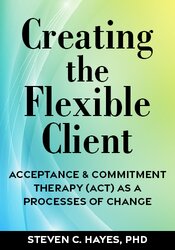Six Practical Tools to Foster Change and Flexibility in Clinical Practice

Therapists often witness how clients try to “fix” or avoid their inner pain, whether that’s through controlling intrusive thoughts, battling difficult emotions, or rationalizing behavior that’s out of line with their values. Acceptance and Commitment Therapy (ACT) offers an alternative path: not through symptom elimination, but through cultivating psychological flexibility.
At the heart of ACT is a powerful idea: the more flexible a person is in how they relate to their inner experience, the more capable they are of taking meaningful action, even in the presence of discomfort. Rather than trying to eliminate distress, ACT guides clients to build a more accepting and values-driven relationship with it.
So how do we, as clinicians, help clients move from experiential avoidance to psychological flexibility? The model offers six core processes. These tools that are more than techniques; they are transformational shifts in how we guide clients toward healing.
1. Cognitive Defusion
Rather than challenging or replacing thoughts (as in traditional CBT), ACT encourages clients to step back from them. That thought is not you—it’s a product of your mind. Use experiential exercises like “Leaves on a Stream” or imagery work (as seen with the “sharp, red umbilical cord” metaphor in the manual) to help clients unhook from painful thoughts.
Clinical takeaway: When a client says, “I’m a failure,” try responding with, “What happens when you treat that as just a thought, rather than a fact?”
2. Acceptance
This means fully opening up to internal experiences—thoughts, emotions, memories—without trying to change or avoid them. Clients often try to “white-knuckle” their way through discomfort. ACT helps them turn toward it instead, cultivating willingness to feel what they feel without judgment.
Clinical takeaway: Normalize distress as part of being human. Frame avoidance as the real source of suffering, not the feelings themselves.
3. Contact with the Present Moment
Clients often become entangled in the past or anxious about the future. ACT uses mindfulness to bring awareness to what’s happening now. This creates space for intentional action instead of automatic reactivity.
Clinical takeaway: Incorporate brief mindfulness practices into sessions, or use language to anchor clients: “What do you notice in your body right now?”
4. Self-As-Context
Clients may believe their painful experiences define them. ACT teaches that behind all those experiences is an unchanging observing self. This self is the context in which thoughts and feelings occur, not the content itself.
Clinical takeaway: Use perspective-taking and metaphor to help clients recognize they are more than their trauma, anxiety, or depression.
5. Values Clarification
ACT emphasizes action rooted in values, or in other words, what matters most to your client. This helps shift therapy from symptom management to life enhancement.
Clinical takeaway: Ask, “If the struggle wasn’t in your way, what kind of person would you want to be?” Use values cards or write obituary/funeral metaphors to explore what gives their life meaning.
6. Committed Action
This is where therapy moves into behavior change. Clients set goals aligned with their values, even if uncomfortable feelings arise along the way.
Clinical takeaway: Reframe goals as willingness-based commitments, not outcomes. For example, “I’m willing to feel nervous in order to reconnect with my sister.”
The Role of Psychological Flexibility in Therapy Sessions and Beyond
Psychological flexibility is not just a goal for our clients. It’s a posture we must also adopt as clinicians. ACT requires us to track these six processes in real time, fluidly shifting as client needs emerge. The real power of ACT lies in its responsiveness: applying the right process at the right moment, not rigidly but relationally.
In practical terms, you might find yourself weaving together mindfulness, values work, and exposure—all within a single session. For instance, helping a client with OCD willingly engage in exposure (touching dirt) becomes a values-driven act, not just a symptom-reduction task. By cultivating psychological flexibility, you can empower clients to build a life of meaning, connection, and vitality.

When therapists can identify these processes, or underlying mechanisms, they’re better equipped to help clients successfully reach their goals.





